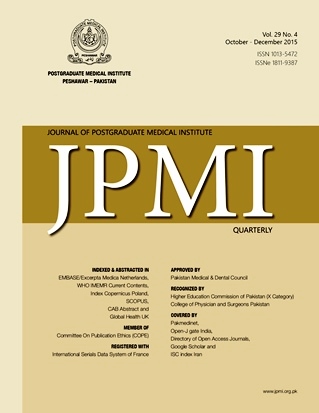A STUDY OF THE SPECTRUM OF PRESENTING SYMPTOMS, DIAGNOSTIC INVESTIGATIONS, TREATMENT AND OUTCOME OF SEVERE MALARIA IN THE ADMITTED CHILDREN OF KUWAIT TEACHING HOSPITAL, PESHAWAR, PAKISTAN
Main Article Content
Abstract
Objectives: To document the spectrum of presenting symptoms, diagnostic
investigations, treatment and outcome of severe malaria in the hospitalized
children of Kuwait teaching hospital.
Methodology: This was a descriptive study using patient case records of
children admitted from 1st January till 31st December 2013. All children with
malaria requiring admission and treatment with parenteral anti-malarial were
categorized as severe malaria and included in the study. Data was analyzed
using Microsoft office Excel 2007.
Results: 32 cases fulfilled the inclusion criteria. Fever was the commenest
presenting symptoms present in 100% of cases (n=32). Fifty percent chil-dren (n=16) had pallor, 12.5 %( n= 4) cough, 9.3 %( n=3) had dysuria and
6.25 %( n=2) had fits recorded as additional presenting symptoms. 71.8%
(n=23) had parasitological confirmation test before commencement of
treatment .100% of this parasitological confirmation was done by peripher -al blood smear/microscopy test. Out of the 23 who had microscopy done
60.86%(n=14) had negative result and 39.13%(n=9 )were positive for plasmo-dium of which,88.88%(n=8)were vivax and 11.11%(n=1) was falciparum.93.75
%(n=30) of the parenteral anti-malarial used was intravenous quinine. All ex-cept one child 96.8 %( n=31) recovered with the anti-malarial treatment used.
Conclusions: Fever and pallor are the two most common presenting symp -toms of hospitalized children with severe malaria. Microscopy remained the
most common investigation for the diagnosis of malaria. Quinine is the most
frequently used drug for severe malaria. The study highlighted the need to
further improve the case management of severe malaria in children.
investigations, treatment and outcome of severe malaria in the hospitalized
children of Kuwait teaching hospital.
Methodology: This was a descriptive study using patient case records of
children admitted from 1st January till 31st December 2013. All children with
malaria requiring admission and treatment with parenteral anti-malarial were
categorized as severe malaria and included in the study. Data was analyzed
using Microsoft office Excel 2007.
Results: 32 cases fulfilled the inclusion criteria. Fever was the commenest
presenting symptoms present in 100% of cases (n=32). Fifty percent chil-dren (n=16) had pallor, 12.5 %( n= 4) cough, 9.3 %( n=3) had dysuria and
6.25 %( n=2) had fits recorded as additional presenting symptoms. 71.8%
(n=23) had parasitological confirmation test before commencement of
treatment .100% of this parasitological confirmation was done by peripher -al blood smear/microscopy test. Out of the 23 who had microscopy done
60.86%(n=14) had negative result and 39.13%(n=9 )were positive for plasmo-dium of which,88.88%(n=8)were vivax and 11.11%(n=1) was falciparum.93.75
%(n=30) of the parenteral anti-malarial used was intravenous quinine. All ex-cept one child 96.8 %( n=31) recovered with the anti-malarial treatment used.
Conclusions: Fever and pallor are the two most common presenting symp -toms of hospitalized children with severe malaria. Microscopy remained the
most common investigation for the diagnosis of malaria. Quinine is the most
frequently used drug for severe malaria. The study highlighted the need to
further improve the case management of severe malaria in children.
Article Details
How to Cite
1.
Ullah S, Ali S, Salahuddin A, Qureshi MSH. A STUDY OF THE SPECTRUM OF PRESENTING SYMPTOMS, DIAGNOSTIC INVESTIGATIONS, TREATMENT AND OUTCOME OF SEVERE MALARIA IN THE ADMITTED CHILDREN OF KUWAIT TEACHING HOSPITAL, PESHAWAR, PAKISTAN. J Postgrad Med Inst [Internet]. 2016 Jan. 3 [cited 2025 Dec. 5];29(4). Available from: https://jpmi.org.pk/index.php/jpmi/article/view/1827
Issue
Section
Original Article
Work published in JPMI is licensed under a
Creative Commons Attribution-NonCommercial 2.0 Generic License.
Authors are permitted and encouraged to post their work online (e.g., in institutional repositories or on their website) prior to and during the submission process, as it can lead to productive exchanges, as well as earlier and greater citation of published work.


